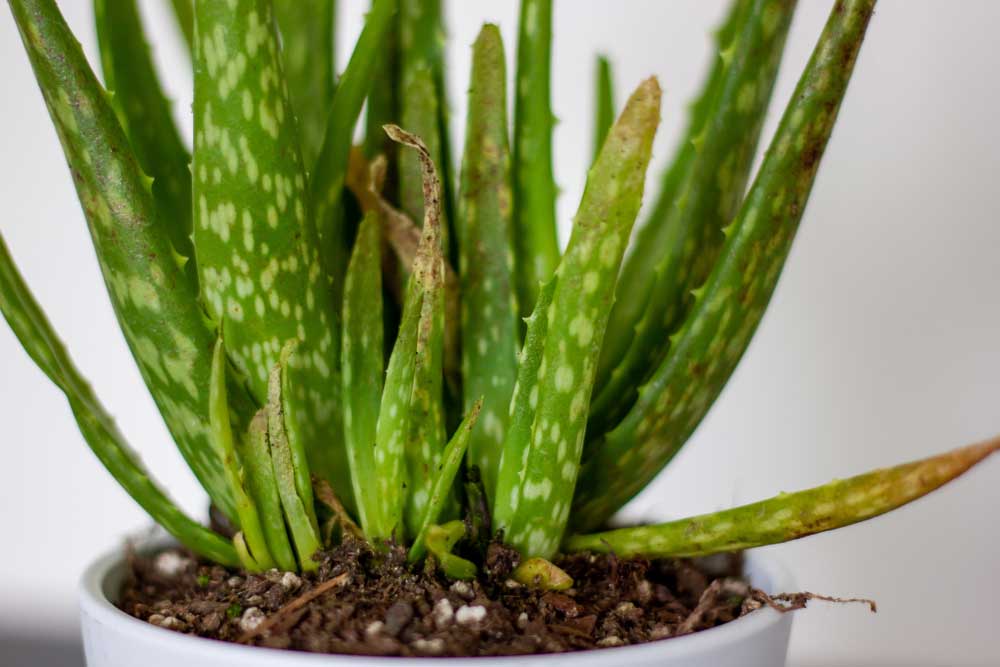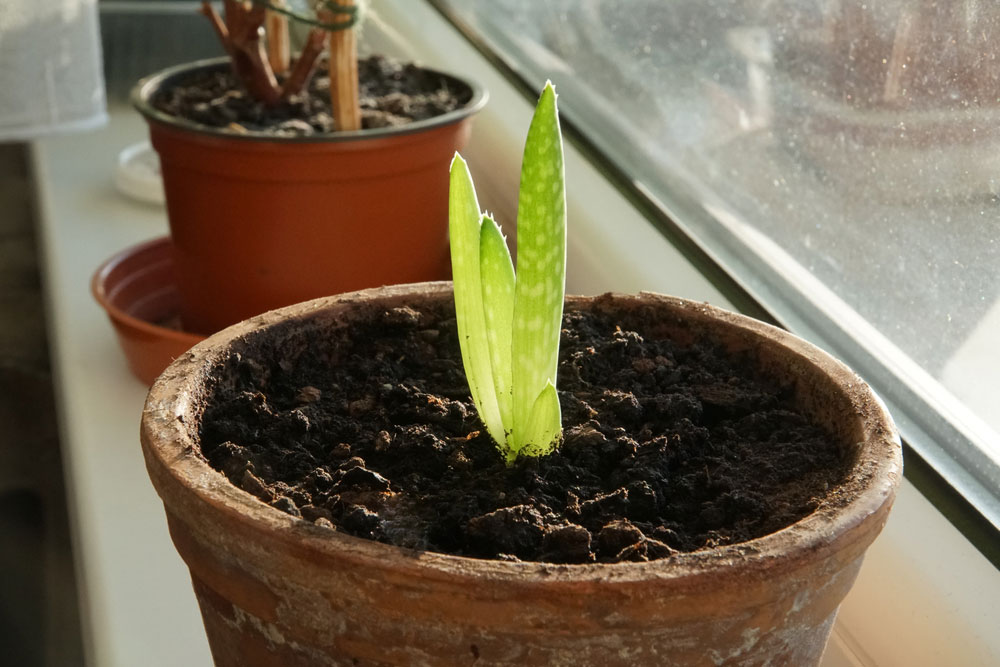
Aloe vera is susceptible to multiple health problems that affect each part of it, from the leaves to the stems and roots. Knowing how to deal with these issues is integral to successfully growing the plant.
This post will walk you through the 10 common problems with aloe vera plants. We’ll also equip you with the best solutions to handle them.
1. Weak Stems
Over-watering is the main cause of stem issues in aloe vera. When you give your plant excessive water, its stems turn squishy.
As the problem continues, the short stems of aloe lose their ability to hold leaves and fall off eventually.
The Solution
To avoid over-watering your aloe, follow these steps:
- Water the plant no more than once every two weeks, except during sweltering weather
- Only water your aloe vera when the top two inches of the soil are dry
- Allow the excess water to drain out of the pot after watering
- Give the plant sufficient time to dry out before watering it again.
2. Stretched Leaves
Ideally, you need to place your aloe vera in a bright location with indirect sunlight. If you put it away from the light, the plant stretches its leaves searching for light.
If you keep placing it away from sunlight for an extended period, it might lose most of its leaves.
The Solution
Transfer your aloe vera to a brighter location with indirect sunlight to stop this harmful stretching process.

3. Dull Leaves
Aloe vera is known for its low water requirement. However, this doesn’t mean you can leave them for months without watering.
If you do so, you’ll start noticing the bright color of your plant’s leaves turning wrinkly and dull.
The Solution
To revive your dull aloe vera leaves, do the following:
- Fill the soil’s surface with water and allow it to trickle down the bottom of the pot.
- After a few minutes, check whether the water has reached the bottom or not. The water might go through the soil without penetrating it if it’s too dry.
- If the soil is too dry, you have to loosen it to allow it to absorb the water. You can use a small shovel or even your fingers to do so.
After finishing this process, check the leaves condition 1 to 2 days later. Give your aloe vera another watering session if they’re still dull and wrinkly.
4. Leaves Turning Yellow
Yellow aloe leaves might seem an issue at first glance. Still, in some cases, this phenomenon doesn’t necessarily indicate a problem.
The leaves of aloe vera, especially mature ones, turn yellow and fall as new leaves emerge.
However, yellow leaves may still signal an issue. The yellow leaves might be the result of a watering problem. This can be overwatering or underwatering.
Lack of nitrogen or iron in the soil is another reason for yellow leaves in aloe vera. In addition, the problem can result from insufficient light exposure.
Solutions
- Check the soil. If it’s extremely moist or dry, you should reconsider how you water it and how much water you use.
- Assess your potting soil quality and ensure it contains the necessary nutrients.
- Repot your aloe vera every 2 to 3 years.
- Ensure your plant gets the required indirect sunlight exposure every day.
5. Red Leaves
Your aloe vera leaves can also sometimes turn red. This usually happens when you move your aloe suddenly from indoors to outdoors.
Despite being a desert plant, aloe vera can’t handle sudden exposure to direct sunlight. That’s because direct sunlight causes sunburn on your plant’s leaves.
The Solution
When moving your aloe from indoors to outdoors, do it slowly. Increase the plant’s exposure to sunlight gradually over ten days.

6. Brown Marks
When you water your aloe vera, some chemicals in the water, like chlorine, can leave residue on the leaves after evaporation. These substances turn into brown spots over time.
Another cause of this issue is when the leaves touch fertilizers, and some residue sticks to them.
The Solution
- Water your aloe vera directly on the soil and avoid spraying the leaves.
- When fertilizing, keep the leaves away from contacting the fertilizer.
7. Sticky Substance on the Leaves
One of the most common insects that affect aloe vera is mealybugs.
These pests absorb the plant’s sap and secrete a sticky substance called honeydew on the leaves. As a result, the plant gets weaker over time and can collapse all together eventually.
Similarly, insects called scales can attack your aloe vera and cause the same harmful effect.
Solutions
- Apply insecticidal soap on the infected leaves.
- Spray diluted neem oil on the area with an infestation.
- Soak a cotton swab in isopropyl alcohol and wipe the leaves with it.
8. Aphids Attack
If you’ve noticed a sudden collapse of your aloe vera leaves, your plant might be under aphids attack.
These pests suck the sap of the plant, which weakens the leaves and makes them susceptible to severe damage.
Even worse, these insects reproduce at an incredibly rapid rate. They might invade the whole plant in a brief time. So, once you detect them, you need to eliminate them promptly.
Solutions
- Spray diluted neem oil on the areas containing pests.
- Apply insecticidal soap on the infected leaves.
9. Squishy Leaves
Overwatering can turn your aloe leaves from vibrant to squishy, droopy ones. As a type of succulent, aloe vera can uniquely store water in its leaves for an extended period.
The plant releases this stored water when it needs hydration. Nonetheless, the leaves’ condition starts deteriorating if you give the plant excessive water.
The Solution
To salvage your overwatered aloe vera, follow these steps:
- Remove the plant from its container.
- Prune unhealthy roots that are brown or black.
- Place the plant in a new container. If you want to use the old container, clean it well first.
- Plant the aloe in a new potting mix.
- Provide the plant with the required amount of water only.
10. Brown Tips

When aloe experiences a lack of hydration, it starts to show a few issues. One of the main problems is that the tips of your plant’s leaves turn brown.
If you don’t address the problem promptly, the whole leaf can turn brown.
The Solution
Water your aloe vera once every two to three weeks in spring and summer. In winter and fall, you may water it every three to four weeks.
Additionally, check the soil for extreme dryness in hot seasons.
Wrap Up
By knowing the 10 common problems with aloe vera plants and their solutions, you’ve passed a significant hurdle in your planting journey. You can refer to this post to find the proper fix whenever you face one of these problems.










